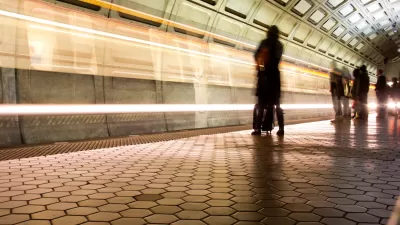Public transit agencies around the country have made a lot of progress in providing access for people with disabilities, but there is a lot of work left to ensure to the full freedoms of mobility.

The letter of the Americans With Disabilities Act law isn't always enough to appreciate the necessity of mobility and equal access for people with disabilities, say advocates as the historic law's anniversary approaches.
Matt Alderton writes for The Washington Post:
President George H.W. Bush signed the ADA into law on July 26, 1990. As the legislation’s 30th birthday nears, advocates say the increased mobility of Americans with disabilities is evidence that it was the right thing to do. That gaps persist, however, is a reminder that work remains.
The scale of the need is greater than many able bodied people recognize. "Nearly 25 million people have a travel-limiting disability, according to the Bureau of Transportation Statistics, which says 1 percent of all Americans — about 3.6 million people — are homebound because of a disability."
The article focuses mostly on the access to transportation required in the law, but those interested in more reading should also see in-depth coverage of the Curb-Cut Effect—a documented effect of multiple benefits from ADA improvements in the public realm.
FULL STORY: Nearly 30 years after the ADA, the nation’s transit agencies report successes and shortfalls

Alabama: Trump Terminates Settlements for Black Communities Harmed By Raw Sewage
Trump deemed the landmark civil rights agreement “illegal DEI and environmental justice policy.”

Planetizen Federal Action Tracker
A weekly monitor of how Trump’s orders and actions are impacting planners and planning in America.

The 120 Year Old Tiny Home Villages That Sheltered San Francisco’s Earthquake Refugees
More than a century ago, San Francisco mobilized to house thousands of residents displaced by the 1906 earthquake. Could their strategy offer a model for the present?

In Both Crashes and Crime, Public Transportation is Far Safer than Driving
Contrary to popular assumptions, public transportation has far lower crash and crime rates than automobile travel. For safer communities, improve and encourage transit travel.

Report: Zoning Reforms Should Complement Nashville’s Ambitious Transit Plan
Without reform, restrictive zoning codes will limit the impact of the city’s planned transit expansion and could exclude some of the residents who depend on transit the most.

Judge Orders Release of Frozen IRA, IIJA Funding
The decision is a victory for environmental groups who charged that freezing funds for critical infrastructure and disaster response programs caused “real and irreparable harm” to communities.
Urban Design for Planners 1: Software Tools
This six-course series explores essential urban design concepts using open source software and equips planners with the tools they need to participate fully in the urban design process.
Planning for Universal Design
Learn the tools for implementing Universal Design in planning regulations.
Clanton & Associates, Inc.
Jessamine County Fiscal Court
Institute for Housing and Urban Development Studies (IHS)
City of Grandview
Harvard GSD Executive Education
Toledo-Lucas County Plan Commissions
Salt Lake City
NYU Wagner Graduate School of Public Service





























